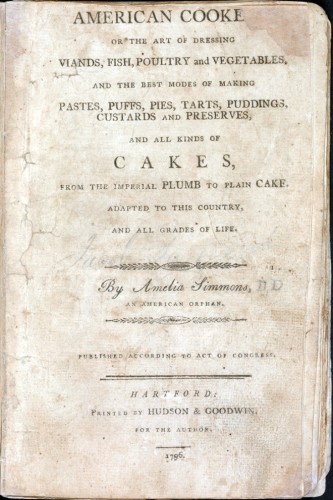By Gregg Mangan
In 1796, Amelia Simmons authored American Cookery—believed to be the first cookbook authored by a European American published in the United States. Printed in Hartford by Hudson and Goodwin, Simmons’s work became so popular that public demand kept it in reprints for 35 years. Today, more important than the delicious meals the book helps readers prepare, American Cookery provides tremendous insight into the language and foods of the era that helped former colonists forge a uniquely American identity.
We know little of Amelia Simmons other than she was an orphan and a woman of modest means. While most of her book detailed common and practical recipes, she also appealed to wider audiences with the inclusion of meals for those with larger budgets. What really made Simmons’s work unique, however, was its recognition of the deficiencies of existing British cookbooks when it came to understanding American culture.
Catering to the American Palate
Unlike British cookbooks of the era, most of Simmons’s recipes centered on the use of corn meal—a staple of the American diet. Simmons used corn in a number of her dishes, including her “Hoe Cake” and “Indian Slapjacks.” In addition to the insights provided by its choice of ingredients, American Cookery speaks to methods of early American food preparation. Most of Simmons’s recipes call for the production of food in large quantities, like a cake that required 2 pounds of butter and 15 eggs. Her syllabub (an alcoholic cider) called for sugar, nutmeg, and then milking a cow directly into the liquor.
One of Simmons’s innovations that made its way back to Europe was her use of leavening agents believed to be the precursors to modern baking powders. This revolutionary practice avoided the need to beat air into the dough or add yeast. Additionally, Simmons’s recipe for spruce beer fermented with molasses helped treat scurvy on long sailing voyages.
Simmons’s Recipes Resonate Today
What perhaps makes American Cookery among the most interesting cookbooks written in the colonial era is its use of language. Some of the terms that first appeared in American Cookery are staples of our national vernacular today. Simmons referred to a lard and butter mix as “shortening” and appears to have coined the term “slapjacks.” American Cookery is also the first American cookbook to use the Dutch term “koekje,” which Simmons spelled “cooky.” This term eventually became “cookie.”
The success of American Cookery facilitated the printing of a second edition in Albany in 1800. Among this edition’s more famous recipes is Election Cake, a dessert requiring 30 quarts of flour, that later became closely identified with the city of Hartford. Simmons’s use of patriotic names for new foods, such as Election Cake, demonstrated both a growing awareness of an emerging national identity and represented a new opportunity for women to promote nationalism and republican virtue through their roles in the domestic sphere. Though subsequent cookbook authors went on to plagiarize much of American Cookery for the next 30 years, Amelia Simmons is still widely considered the “mother of American cook books.”
Gregg Mangan is an author and historian who holds a PhD in public history from Arizona State University.








